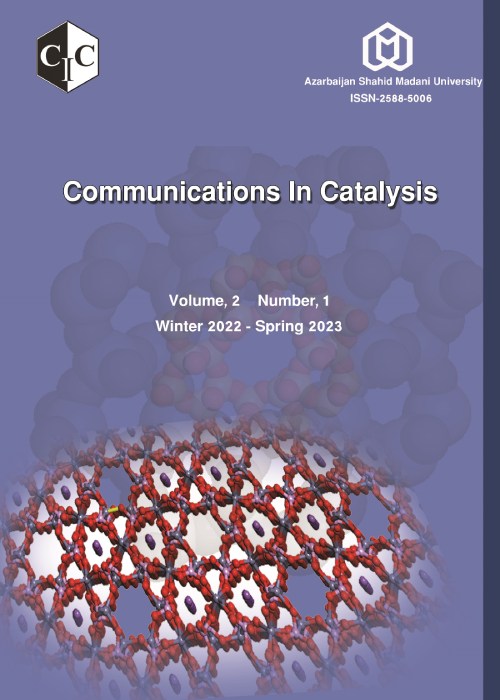فهرست مطالب

communications in catalysis
Volume:2 Issue: 1, Winter-Spring 2023
- تاریخ انتشار: 1402/02/11
- تعداد عناوین: 6
-
Pages 1-18New heterocyclic derivatives were created in this investigation.The most readily accessible Mefenamic acid (M) was combined with thionyl chloride to produce (M1 compound).After treating the (M1) compound with hydrazinecarboxamide to obtain the (M2) derivative, the compound (M2) was subjected to a ring closer reaction with NaOH solution to obtain the 1,2,4-triazole-3-ol ring compound (M3). Compound (M) was reacted with phenyl hydrazine hydrate to produce (M4), and then a ring closer reaction was performed in basic medium with carbon disulfide and hydrazine hydrate to produce (M5).The chemical (M1) was reacted with 3-aminopropanoic acid to produce (M6).To obtain the oxazin ring, (M7) molecule was synthesized by treating (M6) compound with benzaldehyde in the presence of acetic anhydride (M7 compound). The biological and antioxidant activity of the prepared compounds (M1-M7) was studied by (DPPH) method, and the results were good compared to the standard ascorbic acid.Keywords: Mefenamic acid, Hydrazinecarboxamide, Phenylhydrazine, Oxazin, Antioxidant activity
-
Pages 19-34Rhubarb is a plant from the Polygonaceae family, native to Asia (likely Siberia or the Himalayas). In this study, Rheum plants were dried in a cool and dark place, and then the stem and flower powders were extracted using hexane, chloroform, and methanol solvents at room temperature with a Soxhlet apparatus. Column and plate chromatography were then used for the main separation of the extract components. The hexane, chloroform, and methanol extracts of the Rheum stem were separated into 11, 8, and 7 parts, respectively, using the solvent systems of ethyl acetate/petroleum ether, chloroform/methanol/ethyl acetate, and methanol/ethyl acetate/water/acetic acid. The pure compounds were identified using FT-IR, H1 NMR, and C13 NMR spectroscopy.Keywords: Solvent extraction, Column chromatography, Drug, NMR spectroscopy, Soxhlet extraction
-
Pages 35-46
The widespread use of toxic and volatile organic solvents has led to a new challenge in the industry. In this regard, the design of green and biodegradable solvents such as deep eutectic solvents (DESs) has attracted a lot of attention. Molecular-level description of the interactions between HBA and HBA can provide a valuable perspective for the design of these green solvents. In order to, COSMO-RS was used for screening potential DESs qualitatively. Then, we herein performed molecular dynamics (MD) simulations on DES based on Caprylic acid (CAP) and menthol (MEN) which is very widely used in the process of separating pollutants and biomolecules from the water environment and it was observed that the hydroxyl group of menthol plays a key role in the formation of deep eutectic solvents based on MEN and CAP.
Keywords: DESs, MD, Spatial distribution function, Mean-Square Displacement, Caprylic acid, Menthol -
Pages 47-58
In this work, the Structural and dynamic properties of eutectic solvents of choline chloride (Ch+ Cl-) and stearic acid (STA) were investigated using molecular dynamics simulations. Structural properties of the binary mixture of STA and [Ch +] [Cl-] with a molar ratio of 1:1 show a strong interaction between the (COOH) of STA and Cl - anion in the binary mixture. Compared to the low molecular mass of the chloride anion, the strong interaction between the anion and HBD led to a decrease in the migration of this ion compared to acid. The results showed that Cl- anion is an effective species in binary mixtures, playing a key role formation of deep eutectic solvents.
Keywords: MD Simulations, Stearic acid, Choline chloride, Deep eutectic solvent, Dynamic, Structural properties -
Pages 59-70In this study cobalt oxide nanoparticles were electrodeposited on the surface of graphenized pencil lead electrode (GPLE) as a low cost and efficient electrocatalyst for the OER in alkaline media. The prepared cobalt oxide modified GPLE (CoOx/GPLE) was carefully characterized by scanning electron microscopy, energy-dispersive X-ray spectroscopy, electrochemical impedance spectroscopy and cyclic voltammetry techniques. The developed electrocatalyst represents remarkably low OER overpotential of 1.41V (vs. RHE) at the current density of 10 mA cm-2 and Tafel slope of 149 mV dec-1 in 0.1 M KOH solution. The CoOx/GPLE was highly stable and capable for maintaining catalytic activity for at least 5 h. Due to distinctive electrical conductivity, high mass transfer, and adequate active sites of GPLE, the electrocatalytic activity of the cobalt oxide nanoparticles were incredibly improved in CoOx/GPLE.Keywords: Oxygen evolution reaction, Graphene, Cobalt oxide nanoparticles, Electrocatalyst, Pencil lead electrode
-
Pages 71-82As a unique group of advanced polymer-based materials, conducting polymer nanocomposites combine the flexibility and conductivity of the polymer with the distinct properties of nanofillers. Conducting polymers have been widely investigated in various applications. Several conducting polymers, such as polyaniline (PANI), polypyrrole (PPy), poly (3,4- ethylenedioxythiophene) (PEDOT), and polythiophene (PTH) have been loaded with various semiconductor nanomaterials to prepare the composite photocatalysts. In this review, we summarized the synthesis, characterization, properties, and novel applications of conducting polymer nanocomposites especially photocatalytic degradation of hazardous chemicals. The synergic effect between conducting polymers and semiconductor nanomaterials were observed for a lot of composite photocatalysts.Keywords: Conducting polymer nanocomposites, Polyaniline, Photocatalyst, Hybrid, Semiconductor nanomaterials

